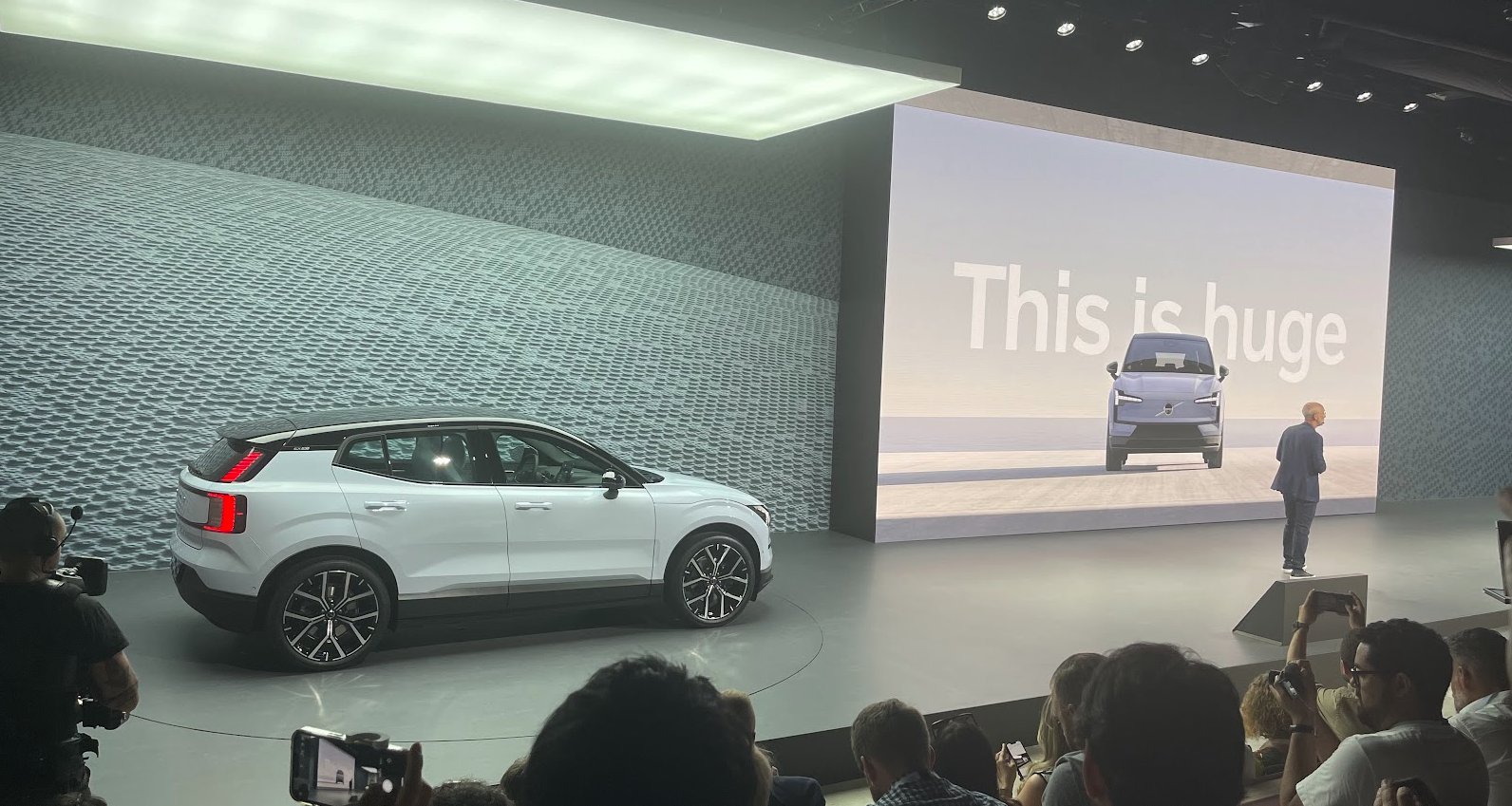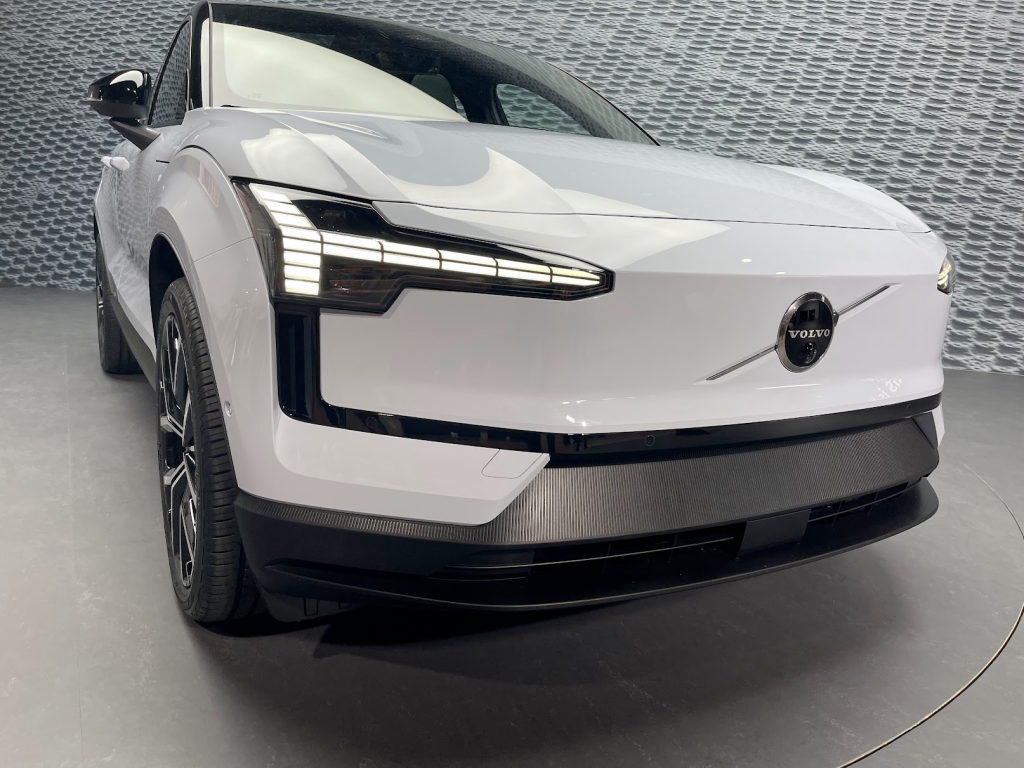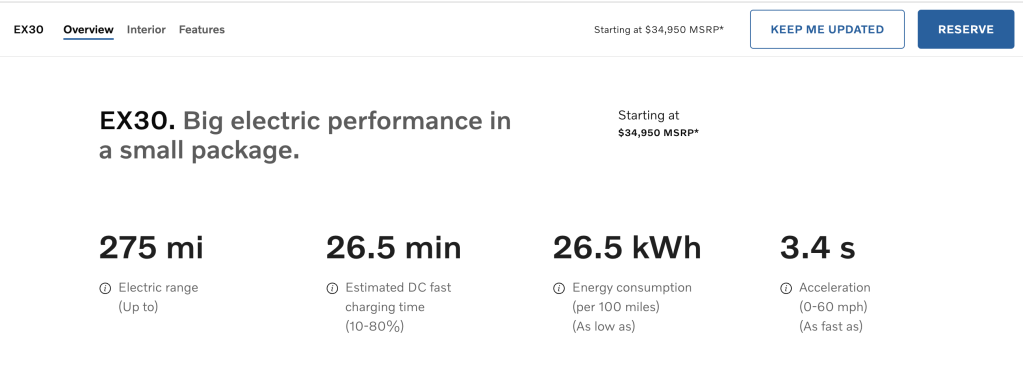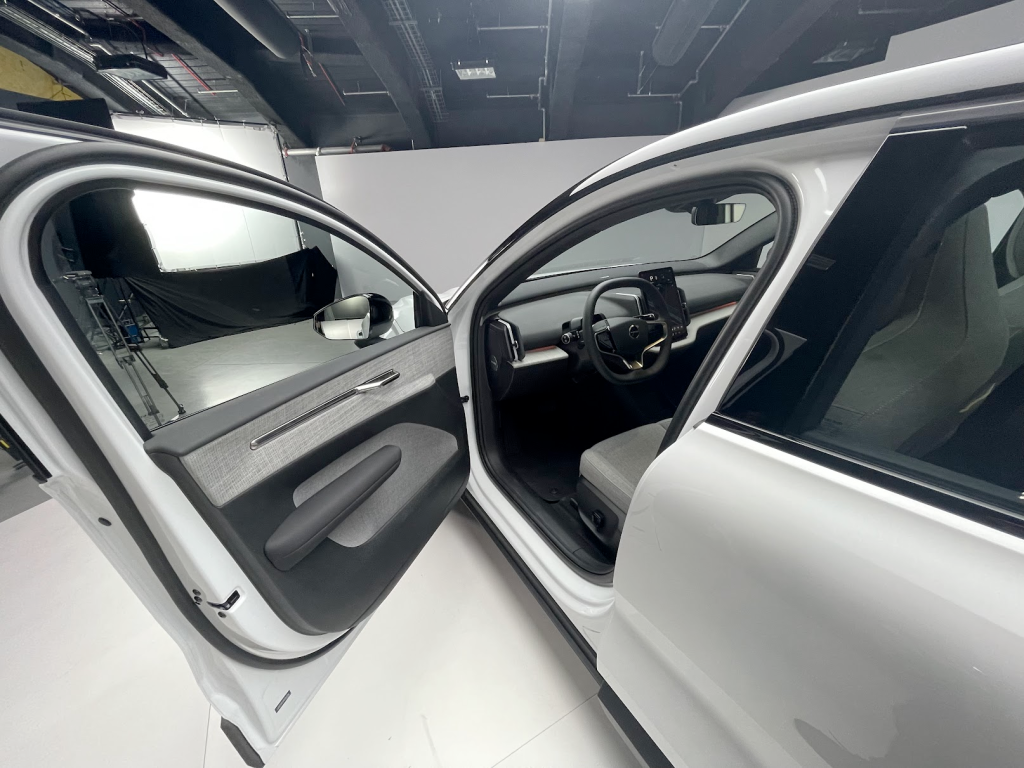
After revealing the gorgeous little EX30 last week, Volvo gave us some access to the folks involved in crafting the vehicle, which allowed us to glean some details about the EV that everyone is talking about…
Akhil Krishnan, project manager for Volvo, sat down with us in the EX30’s surprisingly spacious but still intimate cabin to discuss the thinking. On the 3.4-second 0-60, he noted:
“The acceleration is actually a byproduct of everything else we’ve done with the EX30. Because it’s a smaller car […] and we’ve worked on taking away superfluous items and weight.”
While aerodynamics doesn’t play a huge role in 0-60 acceleration, it does play a role. Getting the vehicle weight down was probably a bigger factor, however.
Volvo’s goal was to have a premium experience in the RWD version, which means it put a 268-horsepower motor in the rear. In an internal combustion engine vehicle, adding AWD doesn’t necessarily mean adding horsepower. In fact, due to the inefficiencies of piping power from one power plant all over the car, there’s often less total power in an AWD internal combustion engine than its RWD counterpart.
However, adding a small 154-horsepower motor to the front wheels yields a total of 422 horsepower and 400 lb-ft of torque. With a car this light, it suddenly matches the 3.4 seconds 0-60 of the Kia EV6 GT and some Porsches and Ferraris.
Why didn’t the X/C40 see this kind of power output? I was told that there were a lot of legacy ICE inefficiencies in the design. The EX30 was designed from the beginning to be an electric vehicle.
The whole interview above is worth a listen, and Krishnan talks at length about the interior decisions that the company made to arrive where we are.

After the reveal, I also got some time with Björn Annwall, chief commercial officer & deputy CEO, who was even more emphatic that the speed was an accident and a byproduct of other things. My interview questions went something like this:
Seth: So, you kind of have a problem from a high-level strategy perspective where your fastest car is also your cheapest car.
Bjorn: You would if you were I would say not for me or a BMW, but if you’re a Volvo where no Volvo customer actually buys Volvo for their acceleration or the kind of the noise of the sound of the engine. Volvo has a different value proposition then to get a bit of oomph I think people see as a benefit, but that’s not why they buy the car.
Seth: Polestar would be more of a brand that would be more of a concern, I guess. But it just seems like an interesting situation. Should we expect all Volvos coming forward, electric Volvos, the more expensive ones, to have a similar type of acceleration?
Bjorn: I think acceleration is commoditizing. I think when you go below a certain level – be that 7 seconds or 6 seconds or 5 seconds, whatever – it doesn’t matter anymore. It’s enough. And Volvo should have enough acceleration to be safe and take you where you want, and this happens to have a kind of 3.6-second acceleration. I think we’re going to stop talking about that, because that’s not what Volvo has ever talked about. I think it’s more interesting to see that the 100-to-zero is 58 meters. I think that’s more important, right? I think it’s more important to understand that you can purchase a Volvo online, you can do that in 36 seconds in the UK. I think those things are more interesting.
Seth: With a 3.6-seconds, these days, someone could say, hey, my Volvo is faster than a Ferrari or a Porsche.
Bjorn: They can do that. But that’s never going to be the proposition by Volvo because it’s faster than Ferrari. I think then you have a different problem.
Björn Annwall, Volvo Chief Commercial Officer & Deputy CEO
So Volvo is genuinely definitely not thinking about quickness with this car. That said, you don’t have to look very hard on the sales page to find the 0-60 speed, and most execs’ faces lighted up with a point of pride even though they will flatly deny they intended to make a little speedster.

There was a lot more info to gain, however. On a “premium-ness” of a $35,000 car:
Now this is a premium car, and it needs to continue to be a premium car. They need to continue to be a premium experience. You get that as you buy the car, as you service the car, as you get part of the brand. This is a step into the brand for many consumers. It’s a very good additional car for many consumers.
So we don’t see this as a mass-market car. We see this as an entry of a premium car in this segment. There is no premium car in this segment, not a full electric car. So we are breaking new grounds, and we’re going to continue to play a premium role. You shouldn’t see this as becoming a mass-market.
We’re a premium player now in the tighter format. And the tighter formats also come slightly tighter budget.
Björn Annwall, Volvo Chief Commercial Officer & Deputy CEO
On Volvo using Tesla’s NACS charger (which a week ago Ford/GM had just announced):
I think you’re right that Tesla has the best premium experience for fast charging. And I think our aspiration is to make sure we as soon as possible make a great charging experience for the mobile customers.
You can have it via the Tesla network. You can have it via some of the other networks. But then you have to become better at some of those things from automatic payments and taking away a lot of the hassle around it. And we’re working with that as a high priority. I can’t give you any further details.
[Volvo is] open to anything that makes life easier for all of our customers. Then, in the end, things have to work out, but we’re open to we’re going to be electric company. We need to have a great, convenient charging experience for all the customers. I think we have a large part of the US with existing charging infrastructure, but it could be improved.
Björn Annwall, Volvo Chief Commercial Officer & Deputy CEO

On how Volvo got the price so low:
There’s no silver bullet. There is a lot of things. One thing is we’re starting from a technological platform that Geely has developed that is very well done and where we share some of the investments with other brands, and we also share in the infrastructure in the factory in China where we produce it. So tooling investments are all very efficient done together. So that’s one thing.
The other thing is: as we engineered and designed this car, this Volvo car on that platform, we actually had a very ‘resourcefulness’ and ‘cost-mindedness’ at the start. It’s quite interesting: sustainability and cost efficiency are very much the same things, right? Less material. Think about what material [we] have, less waste, take out complexity. That was really the leading thought.
And there’s no one silver bullet. There’s a lot of things. I think there’s the sound bar – one speaker rather than having four or six separate loudspeakers. That’s a good example. Less material, less complexity, very good experience, nice design.
So a lot of those small things have made it better. And then the fact that they add an LFP battery into the mix, which I think makes total sense. The downside of LFP is slightly lower range, slightly slower fast charging. But for a vehicle like this, which many people used as kind of the more local commute in cities or as a second car, that is not the problem. So all those things combined makes a very premium car but at an affordable price.
During its investor day, a day after the Volvo EX30 launch event, we learned that Volvo intended to hit a 20% margin on the EX30, and it thought it would be one of the best-selling cars in its lineup. From the reactions it’s getting, I tend to agree.

FTC: We use income earning auto affiliate links. More.



Comments